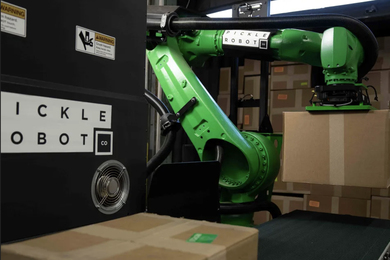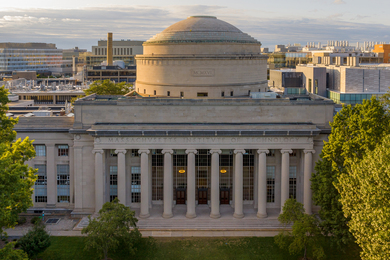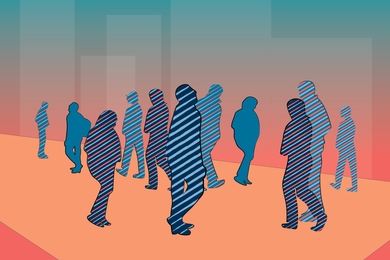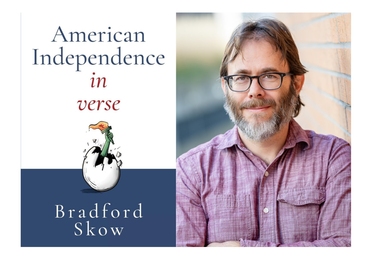OUTSTANDING ALUM, SCARY STUDENT
Professor Woodie C. Flowers has been enshrined at his alma mater, Louisiana Tech University.
The Pappalardo Professor of Mechanical Engineering was honored as an Outstanding Alumnus at the school's campus in Ruston, LA, on October 2. Professor Flowers received the BS in mechanical engineering from Louisiana Tech in 1966.
Professor James D. Lowther, chair of mechanical engineering at Louisiana Tech, coordinated the ceremonies, which included a reception and the unveiling of a plaque on which Professor Flowers believes his likeness resembles Mark Twain.
The youthful Flowers made a profound impression on at least one member of the Louisiana Tech faculty. "He built a unique physical model for a project that involved thermally������������������produced water currents," said Professor Lowther. "His thinking was way outside the range of thinking of students at that time." While Professor Flowers does not recall that specific project, he acknowledges that the story has the ring of truth. "I did scare the hell out of the faculty with some large Engineer's Day projects," he said.
������������������
SPAM-KU RULES
Research scientist John Nagamichi Cho works in -- or perhaps has transcended -- the department of earth, atmospheric and planetary sciences (EAPS) if his book SPAM-ku: Tranquil Reflections on Luncheon Loaf (HarperCollins) is any measure. An anthology of 162 haiku poems dedicated to the ultra-high-fat, mortally high-sodium canned pink sandwich meat, SPAM-ku arose from Dr. Cho's tongue-in-cheek web site invitation. According to a story in the October 6 San Francisco Examiner, "thousands of poems spilled across the wires, and the total now stands at more than 10,000" of the three-line, 5-7-5 syllable poetic form.
"I threw it out on the web and SPAM-ku arrived," Dr. Cho told the Examiner. "I got hooked on it and the rest is history."
SPAM-ku chapter titles include "Anticipation and Desire," "Physics and Mathematics," and "Sex and Romance." Dr. Cho himself is described as the "grand master of the form."
LIGHTS! CAMERA! ACTION!
Beware! Camera crews from around the world are converging on campus.
A production company for the Discovery Channel's Extreme Machines series last week filmed WAM, the robotic arm developed by Professor Jean-Jacques Slotine of mechanical engineering and colleagues, and robots in the Leg Lab directed by Professor Gill Pratt of electrical engineering and computer science (EECS). Both are also affiliated with the Artificial Intelligence Laboratory.
Japan Satellite Broadcasting Inc. (known as Wowow) was at MIT on October 10 to shoot footage for a segment on a cross-country train trip for the program "Railway Story." The scenes on campus will be shot for high-definition television (HDTV) transmission.
In September, NDR -- German public TV -- was here to film two stories. One was on the robotic pike being developed by researchers in Professor of Ocean Engineering Michael Triantafyllou's lab; the other was on the autonomous underwater vehicles being developed by MIT Sea Grant's James Bellingham and colleagues.
Reporters from science shows on Italian public television, Chilean TV and England's BBC have also called recently for help in arranging visits to MIT.
Professor Rodney Brooks's humanoid robot Cog continues to be of great interest to television. Since April of this year, the MIT News Office has received requests from 21 TV programs for a 45-minute video of the robot produced by MIT Video Productions. Professor Brooks of EECS directs the AI Lab.
ANCIENT AND MODERN
Susan Slyomovics, the first holder of the Genevieve McMillan-Reba Stewart Chair in the Study of Women in the Developing World, discussed her research in Israel and Palestine as part of the 1998 Max Wasserman Forum on Contemporary Art, held in Bartos Theater on October 13.
Professor Slyomovics' new book, The Object of Memory, explores how memories of place -- in particular, a Palestinian village now occupied by Israeli artists -- are constructed and passed on. The Wasserman Forum, titled "Emerging Portraits: Women of the Arab-Islamic World," was moderated by Sarat Maharaj of Goldsmith's College in London. A third speaker, Shirin Neshat, discussed photographic self-portraiture as a form of cultural understanding.
FOR RICHER OR POORER
"Your wealth today is an excellent forecast of your wealth tomorrow," commented Andrew Lo, the Harris and Harris Group Professor at the Sloan School and director of the Laboratory for Financial Engineering, in a discussion of the Efficient Market Hypothesis (EMH) in the October issue of Discover magazine.
Rather than be depressed by this, Professor Lo finds in EMH a "Zen-like" beauty. According to his research, the market behaves predictably -- thanks to competing traders' cancelling out one another's manias -- until it doesn't, thanks to fluctuations that make "the price of a stock stumble around a given value like a drunk around a lamppost." He said this is an example of the Random Walk Hypothesis.
In accompanying articles, two other MIT professors are quoted. Professor Paul Krugman of economics: "E-money will solve some problems of a hard-cash econ-omy��������������������������� on the other hand, a system of purely virtual money might be subject to severe instability."
Professor Marvin Minsky of EECS: "Once the intelligent robots come, we could all be as wealthy as kings."
KID STUFF
Professor Steven Pinker of brain and cognitive sciences, director of the Center for Cognitive Neuroscience, has predicted "a turning point in the history of psychology."
In a new book, The Nurture Assumption: Why Children Turn Out the Way They Do; Parents Matter Less Than You Think and Peers More,author Judith Rich Harris argues that genetics and a child's peer group are mostly responsible for how individuals turn out.
Professor Pinker, who wrote the book's foreword, noted in a September 17 Boston Herald article that parents can do their children a disservice by forcing them into peer groups where the child is doomed to fail. "If your kid looks like a nerd, a dweeb or a Melvin," he said, "that could harm the child."
QUANTUM HO
In its October 12 issue, Science News reported that a research team led by David G. Cory, associate professor of nuclear engineering, is applying nuclear magnetic resonance, a technique commonly used in medicine to reveal tissue structure, to find and fix errors in quantum computers. "Bits of information in a quantum computer suffer constant peril��������������������������� [with] small amounts of random energy easily sowing errors that are deadly to reliable computing," the article said. Professor Cory's team expects to achieve "full-blown" error correction in the next few months.
PAINTING THE TOWN
Cambridge Schools Superintendent Bobbie D'Alessandro issued an official thank-you note to Sloan School of Management students for their help in cleaning and painting five Cambridge public schools.
"Once again I am saying thank you to MIT. We are most appreciative of the work of the young men and women who are helping us," she told the Cambridge Chronicle on September 10. "Their efforts will help to create a better environment for our students."
The 360 Sloan students, who worked in teams of 60, spent two days on the annual community service event. The City of Cambridge supplied the paint.
YOU DO NEED A WEATHERMAN
Discovery Online features Professor Kerry Emanuel of EAPS in its multimedia hurricanes package. The online essay includes his recipe for a "hypercane" -- the mother of all superstorms -- plus comments on ideal "womb" conditions for hurricanes.
Karen Watson, executive science producer/editor for Discovery Online, told MIT Tech Talk that Professor Emanuel was "a terrific help."
"He did a bang-up job on our recent audio Webcast Science Live!" said Ms. Watson. "His time and expertise made a huge difference in the quality of our coverage, and we very much appreciated his willingness to work with us."
To find Discovery Online's hurricane package, go to http://www.discovery.com/stories/science/hurricanes/hurricanes.html.
SPACED OUT
Edwin "Buzz" Aldrin (ScD 1963) can't get enough of that moon-walking. The second man to walk the lunar surface now devotes an active retirement to promoting tourism in space in general and, in particular, the X-Prize, a $10 million award to the first company to build a reusable rocket for passenger space flights. Dr. Aldrin's third novel will appear next year, in time for the 30th anniversary of his historic walk.
SAGE
CNN, in a September 15 broadcast, asked "What do you make of the new paradigm thinking about the economy?" Institute Professor Emeritus Paul Samuelson, 1970 Nobel laureate, answered, "All I would say is, hang onto your wallet."
TROPICAL SHIFT
A review of Good Government in the Tropics, a new book by Judith Tendler, professor of urban studies and planning, appeared in both the Boston Globe and the Chicago Tribune in late August. In Good Government, Professor Tendler analyzes how public service improved dramatically in Ceara in northeast Brazil, and offers a basis for policy advice that is grounded in positive experiences of developing countries.
A version of this article appeared in MIT Tech Talk on October 21, 1998.





